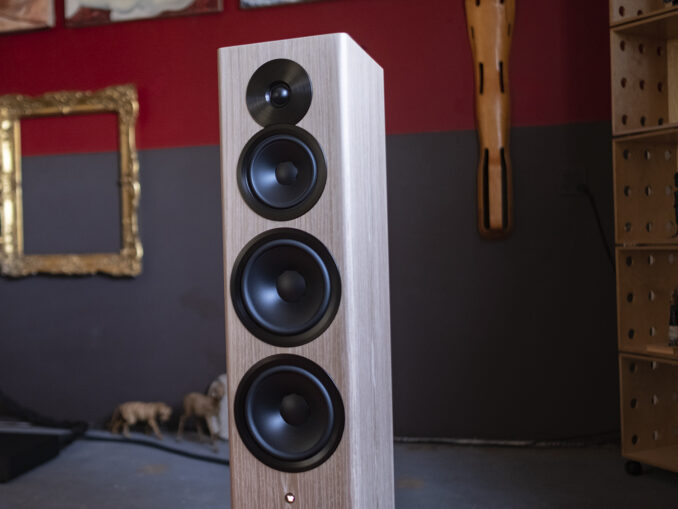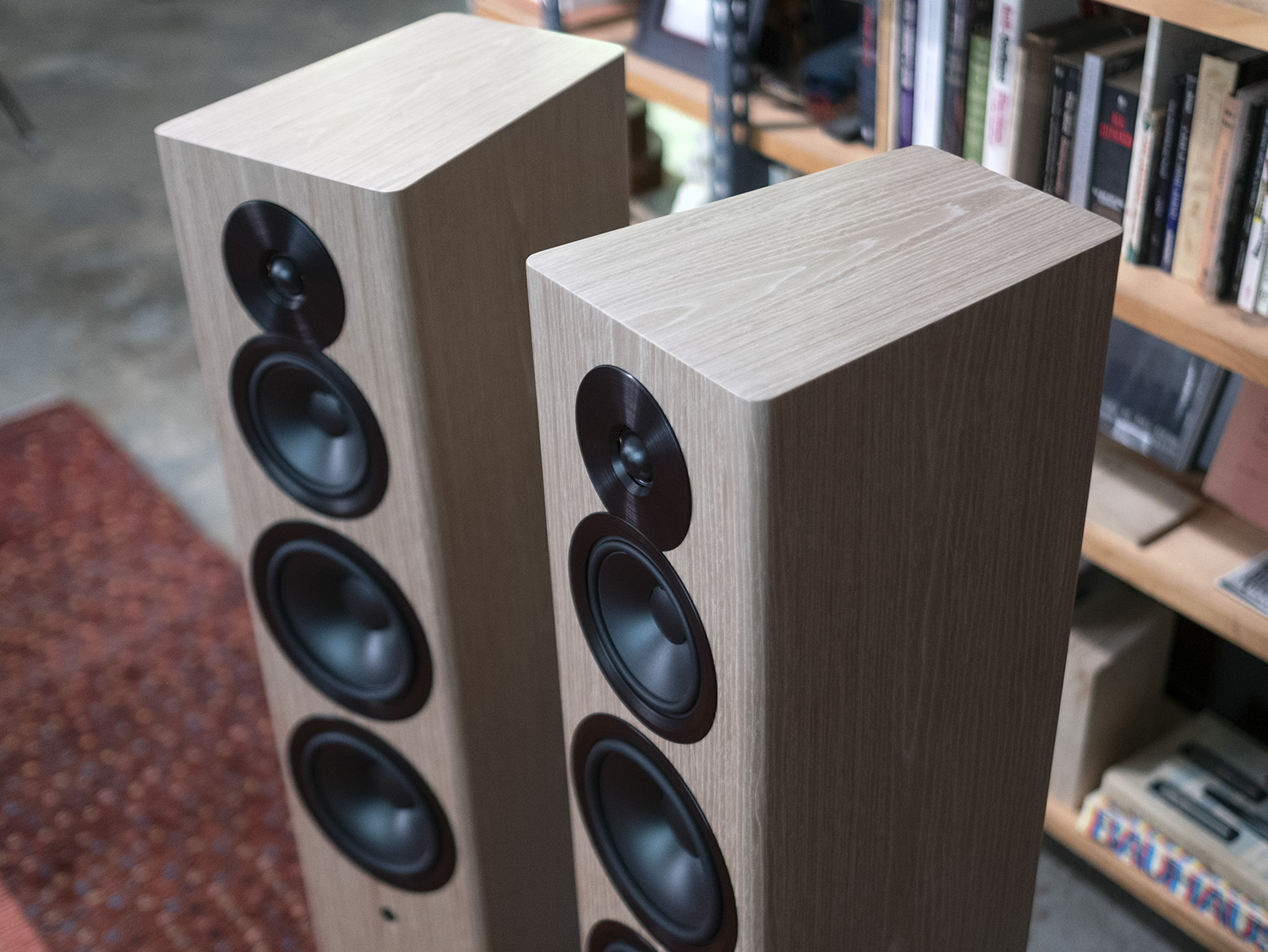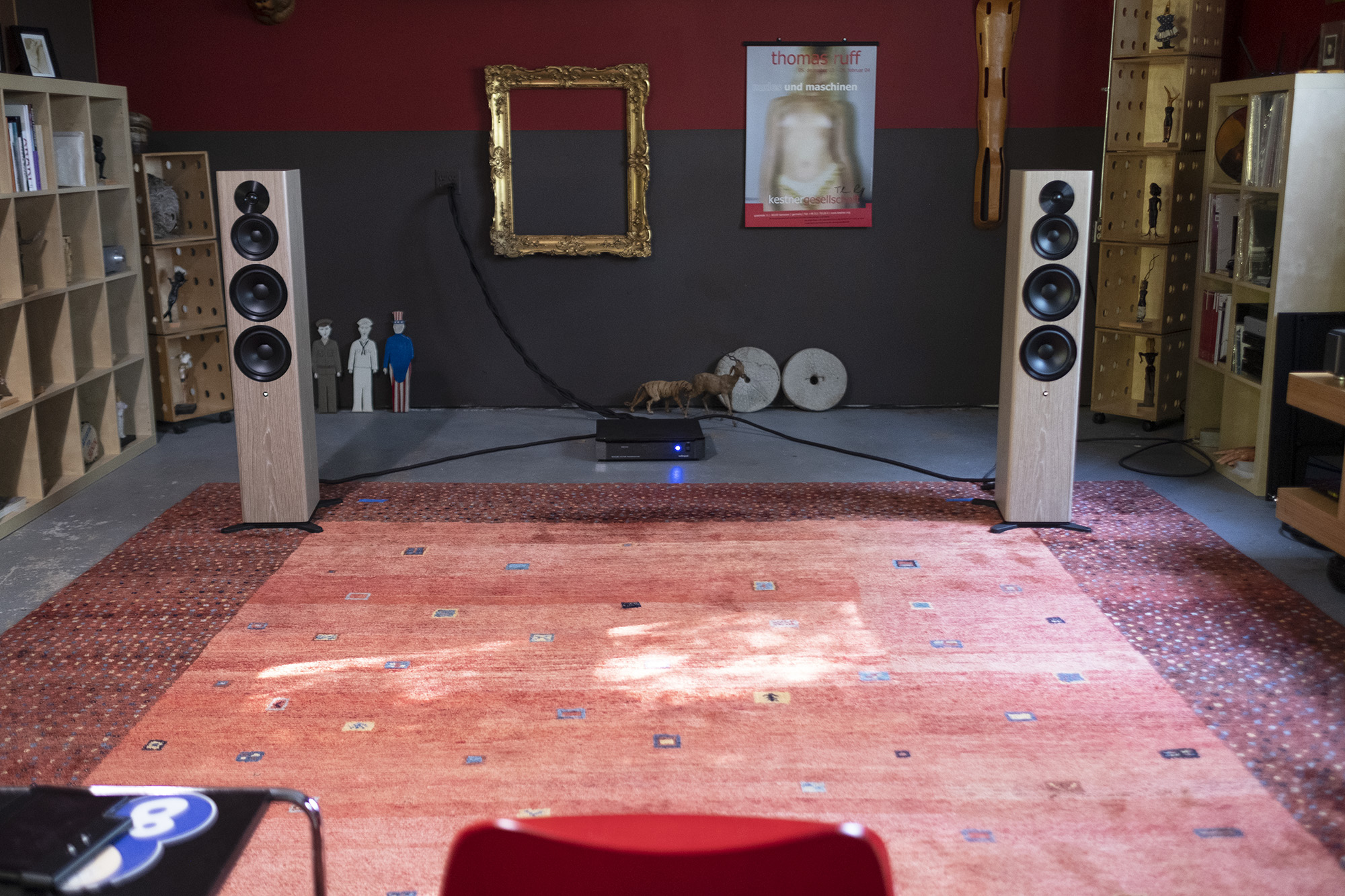
Two speakers + two power cords = endless music on tap that sounds as good, or better, than separates. That’s what the Dynaudio Focus 50 have to offer. Interested?
My impression is there’s lingering doubt floating about, that active wireless speakers trade convenience for performance. In my experience this has been the case in some instances, but the Dynaudio Focus 50 will wipe away those fears in no time flat if you just lend them an ear and some time with your favorite tunes.
Anyone who has been around audio for any amount of time already knows about Dynaudio, a company founded in Denmark in 1977 (!). Dynaudio initially built speakers using available drivers in their own cabinets with custom crossovers but when their search for higher performance drivers with specific parameters came up short, they decided to build their own in house. Word got our about the quality of the Dynaudio drivers which led to the company’s entrance into the OEM and DIY markets and the rest is hifi history. Today, Dynaudio employs over 300 people and offers a wide range of speakers for home audio, pro audio, custom installation, and car audio.

I’ve reviewed a number of Dynaudios over the years including the crazy-good desktop rocking Excite X14A Powered Speakers (more info) and the Focus 30 XD active wireless speakers (review), a precursor to the Focus 50 under review today.

The Focus 50 are configured as a Primary and Secondary speaker pair, the Primary housing most of the inputs you need to get your music into, and out of, the Focus 50. There’s also a Coax output to hard-wire the pair together if you don’t want to use their 24-bit/96kHz-capable WiSA wireless connection. I ran wireless inter-speaker the entire time.

On the Primary side, there are a number of digital audio inputs (2x Coax, 1x Toslink), a pair of analog RCA inputs, Sub out, and Coax out to connect to the Secondary’s Coax in. You can connect the now Roon Ready (yay!) Focus 50 to your network via WiFi or Ethernet which also support Bluetooth, Apple AirPlay, Google Chromecast, Tidal Connect, Spotify Connect, and Internet Radio. The free Dynaudio Setup & Control app provides access to a host of options including initial setup, playback control, and various functions including Room Optimization presets (neutral, near wall, and corner), and Frequency Balance (light, neutral, and dark) to tailor the Focus 50’s sound to room and taste. A regular hand held remote is also part of the package. I ran with Roon for the duration of this review and used Roon’s volume control to control the Focus 50’s level.

But wait, there’s more in the form of Dirac Live, which allows for automatic room compensation based on measured in-room response. I ran through the Dirac setup process in no time as I already own a miniDSP UMIK-1 USB calibrated measurement microphone which I connected to my MacBook Pro running the Dirac software. This software walks you through the entire process, with pictures, making it so simple even a fine arts major from NJ can do it. It’s worth noting that you can customize Dirac’s approach by limiting the frequency band it corrects and /or adjusting the final recommended correction curve to taste. Seeing as this process is room and preference dependent, I have no doubt that Dirac Live can be a life saver for some users so it is a very welcome option.

Inside each speaker you’ll find three class-D amplifiers from Pascal in Copenhagen: one 110W unit for the Cerotar tweeter, a 280W amp for the Esotec+ midrange driver, and one 280W amp for the twin Esotec+ bass drivers (which are driven in parallel). I can tell you that this adds up to more than enough power to fill a Barn and then some.

The review pair are finished in the lovely Blonde Wood finish. Walnut Wood, High Gloss Black and High Gloss White lacquer are also available. Magnetic ‘Smart” grilles are included so that after snapping them in place, the speakers automatically adjust their response to correct for the grilles presence and sonic impact. Smart! As I hope you can see, the Focus 50 are built to exacting standards, something I’ve come to expect from Dynaudio.

I asked my contact at Dynaudio, the ever helpful and endlessly knowledgeable John Quick, What are five things people should know about the Focus range of speakers? Here’s his response:
1. The new Focus range shares virtually nothing with the previous two generations of Focus. Every major component is different and improved: the drivers, cabinets, amplifiers, central DSP engine, and the streaming platform are all new.
2. Two of the most critical elements of the new Focus are derived from Dynaudio flagship offerings: the Dynaudio DSP engine and Pascal amplification were first employed in the Pro Core range, and the Focus drivers are trickle-down variants of what was developed for our flagship Confidence range.
3. The Dynaudio DSP engine takes a very pure and unique approach to input signal processing. All incoming signals are sample rate converted only once to match either the 48kHz, 96kHz (WiSA wireless) or 192kHz (wired) inter-speaker connection method. This dramatically improves fidelity (by avoiding multiple SRCs), but it also provides for a class-leading 1ms group delay (latency) between right and left channels, which ensures rock-solid imaging and resolution matching the very best traditional high-end systems available.
4. The DSP engine was entirely designed in-house and is manufactured for us in Denmark within 60 miles of the factory in Skanderborg. Our faith in the solidity and reliability of this platform and the partnering electronics is reflected in our class-leading warranty: 5 years on electronics, 8 years on the rest of the loudspeaker (with registration).
5. The streaming and DSP platforms are designed for class-leading versatility and future performance and feature upgradability.
I plugged the Focus 50 into an AudioQuest Niagara 3000 Power Conditioner using two lengths of AQ’s Thunder High-Current AC power cables and ran a length of AQ Diamond Ethernet cable to the Primary speaker. Yes, I prefer to wire up my network connections. Call me old fashioned.

I admit it—when staring at the Focus 50 knowing these two speakers are the entire hifi before hitting “Play” for the first time can feel like the moment immediately preceding the first step in a tight rope walk. But I am here to tell you it’s OK. It’s completely safe and within a few minutes of listening you’ll be smiling and streaming your favorite tunes, head shaking in near disbelief that all of this goodness is coming out of a pair of active speakers with a DAC inside.
Big, bountiful and shapely bass filled the Barn from King Midas Sound / Fennesz Edition 1 from 2015. King Midas Sound is comprised of Kevin Martin (also known for his work under The Bug moniker), singer/poet Roger Robinson, and vocalist Kiki Hitomi who are joined by Austrian guitarist / electronic wizard Fennesz for a deep dive into atmospheric funk, and the Focus 50 threw out a bigger than Barn-sized sound image with music emanating from more than an arm’s length beyond either side of both speakers while extending up to the 12’ ceilings and much deeper than the Focus 50’s 5’+ distance to the front wall. Cavernous, creepy (that’s the music’s fault) and completely captivating, the Focus 50 did a superb job unraveling all of the sonic elements at work on Edition 1, from the tiniest squeak to the largest squall.
Mystic Sisters’ City Of Caterpillar, released back in September on Relapse Records, finds the Richmond, Virginia-based band back after a 20-year absence from the recording scene as fit as ever. This is wiry, angular and angry music comprised of guitarist/vocalist Brandon Evans, guitarist Jeff Kane, drummer Ryan Parrish, and bassist/vocalist Kevin Longendyke. Its also very good sounding, if you go for this kind of music. I do. The Focus 50 dug into the dense angrier bits with aplomb while delivering the sound and fury of each part with ease. I suppose some people hear noise when they listen to music like City Of Caterpillar just as some people see nothing more than a mess of lines and colors when perusing a Picasso but for those who listen (or look) in with all their attention, rewards await and the Focus 50’s presentation is your ticket to ride.
That’s not to say I’m all brutish and mayhem, as I enjoy a good tear-jerker as much as the next person. To my way of hearing, Julien Baker consistently delivers the goods from relatively simple parts including her guitar and touching, oh-so-touching, vocals. Sprained Ankle is her solo debut from 2015, written while Baker was still in college, and I only just started traveling down its lonesome roads recently. Featuring just guitar, acoustic and electric, piano, and Baker Sprained Ankle is a study in intimacy and the Focus 50 got every part out and into the Barn in reach out and touch it physical form. This music moves me with its simple rawness so that every squeaky slide up and down the fretboard add to the atmosphere under and over Baker’s touching, oh-so-touching, vocals. Harmonic string plucks rang out and dissolved into the Barn air with the resounding crispness of the real thing, while Baker’s voice took up center stage with real physical form. Stunning.
I don’t know about you but if I add Mystic Sisters to Julien Baker and shake, I get a hankering for Joy Division. Closer from 1980 is one of the band’s two classic studio albums and anyone who knows this music knows this music’s sound is singular, even though many a band has tried their best to get there. The thing about Joy Division was each member—guitarist Bernard Sumner, bassist Peter Hook, drummer Stephen Morris, and singer Ian Curtis—had a very distinctive sound and together they made magic. Pure music magic unlike anything before or since. The Focus 50 recreated the vacant sound of Closer, that industrial space of sound, pushing and pulling with elusive intimacy, a vast warehouse filled with unique voices given full voice by the Focus 50 in Barn-filling wonder.
During their more than a month stay, I devoted a lot of time and attention to the Focus 50 and their way with a long list, too long to list, of music from all corners of the world in all shapes and sizes. From the mystical wanderings of late Schubert, to Gesualdo’s Tenebrae as performed by The Hilliard Ensemble, to Non Band’s wonderful wiseguy self-titled 1982 debut (recently re-released on vinyl), to Special Interest’s stunningly badass new album Endure, the Focus 50 kept my attention wrapped around the musical message with nary a thought of reproduction. As it should be.

The Focus 50 were truly plug in, two power cords and an Ethernet cable, and play. A complete stereo comprised of nothing more than a pair of handsome floorstanding speakers that can access the endless stream of music available from Tidal, Qobuz, local files and more and turn it into a captivating and rewarding musical experience on par with separates that could cost you a heck of lot more.
If you’ve been waiting for the sound quality of active wireless speakers to catch up to separates, that time has come with the Dynaudio Focus 50. Highly recommended for those seeking more from less.
Dynaudio Focus 50 Wireless Active Speakers
Price: $11,000/pair
Company Website: Dynaudio
Specifications
Analogue inputs (primary speaker): 2x RCA
Digital inputs (primary speaker): 1x Toslink, 1x RCA
Outputs (primary speaker): 1x RCA (for inter-speaker link), 1x Sub RCA, 1x Trigger
Digital inputs (client speaker): 1x RCA (for inter-speaker link)
Wireless inter-speaker connection: WiSA (up to 24-bit/96kHz)
Network: Wi-Fi, Ethernet, Bluetooth
Frequency response (±3dB @ 85dB): 20Hz-22kHz
Frequency response (-6dB dynamic): 18Hz-36kHz
Box principle: Sealed
Crossover: 3-way DSP-based
Crossover frequencies: 390Hz / 4.7kHz
Woofer: 2x 18cm MSP
Midrange: 15cm MSP
Tweeter: 28mm soft dome
Amplifier power: 280W (woofers), 280W (midrange), 110W (tweeter)
AC power input: 100-240V 50/60Hz
Standby power consumption: < 0.5W
Maximum power consumption: 280W
Weight: 33.5kg / 72.8lb
Dimensions (W x H x D): 215 x 1140 x 305mm | 81⁄2 x 447⁄8 x 12in
Dimensions with feet/grille (W x H x D): 305 x 1187 x 401mm | 12 x 463⁄4 x 153⁄4in
Finishes: Black High Gloss, White High Gloss, Blonde Wood, Walnut Wood
Grille: Black magnetic Smart Grille plus auto-sensing EQ

